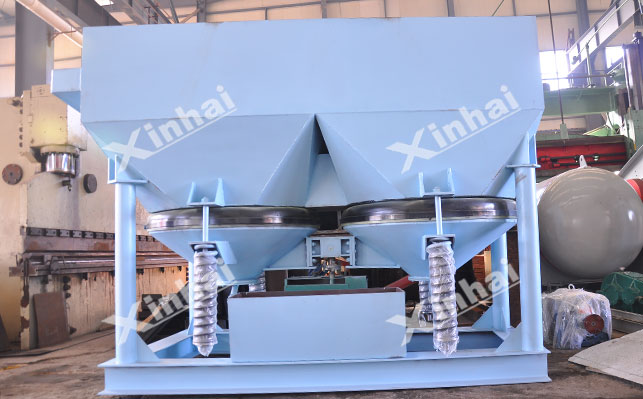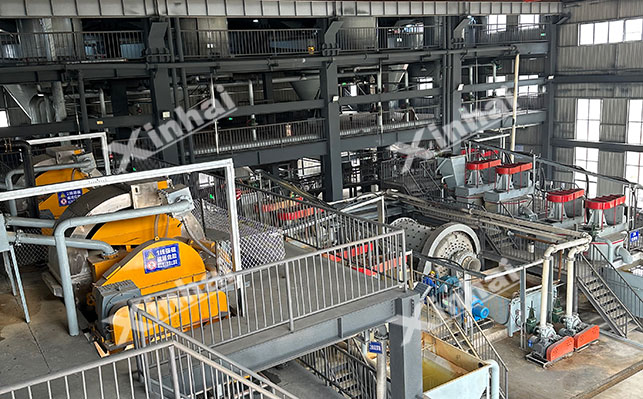
15311826613
Click to add WeChatManganese ore is a major raw material in the manganese industry, a commonly used desulfurizing and deoxidizing agent in the steel industry; a catalyst for the preparation of manganese dioxide in the chemical industry; and a cathode material for the production of zinc-manganese dry batteries in the energy sector. With the gradual depletion of rich manganese ore, manganese oxide has gradually become a major development target. Common types of manganese oxide minerals mainly include pyrolusite, schist, and manganese ore. Let's learn about the these three manganese oxide ore beneficiation methods !
Pyrolusite is a weathered manganese oxide ore, often closely associated with pyrolusite, manganese ore, and clay minerals. The embedded particle size ranges from coarse (above 1mm) to fine (below 0.01mm). Especially in weathered manganese oxide ores, it is often encased in clay minerals as a cement, making dissociation difficult.
For this type of manganese ore beneficiation, a combined method is often employed.
Washing-Gravity Separation:
Before gravity separation, the ore is washed to remove impurities and prevent mud from interfering with subsequent separation. Then, it is classified using a vibrating screen. During gravity separation, the coarser particles (8-30mm) are coarsened using a jig, while the finer particles (0-3mm) are finely separated using a shaking table, ultimately yielding manganese concentrate.

Washing-Intensive Magnetic Separation: This process also begins with washing to remove a large amount of muddy impurities. Then, the ore particles are ground to approximately 70% -0.074mm using a ball mill, allowing for complete liberation of the pyrolusite particles. Finally, a high-gradient magnetic separator or an intense magnetic separator is used to utilize the weak magnetic properties of the pyrolusite for magnetic separation, separating it from the non-magnetic gangue.
Washing-Gravity Separation-Magnetic Separation-Flotation: This method is suitable for pyrolusite with complex composition and uneven particle size distribution. First, washing and desliming are performed. Then, gravity separation removes a large amount of waste rock, magnetic separation further enriches the concentrate, and flotation improves the final concentrate quality. Generally, specific collectors such as fatty acids are used in flotation to remove residual silicate and other gangue minerals.
Pyrolusite is formed when low-valence manganese compounds are oxidized to manganese dioxide, gradually accumulating to form pyrolusite. Its theoretical manganese content is 63.19%. Its crystal structure belongs to the tetragonal crystal system. Ideally, the crystals are needle-shaped or columnar, but complete crystals are rare in nature; it mostly occurs as massive, granular, or powdery aggregates.
Common beneficiation methods for this type of mineral are as follows:
Gravity separation: Suitable for processing coarse-grained (particle size > 0.2 mm) pyrolusite, gravity separation is achieved through spiral sluices and jigs. Spiral sluice gravity separation utilizes the combined forces of centrifugal force, gravity, and water flow to separate manganese from gangue; jig gravity separation uses periodic pulsating water flow to separate mineral particles into strata based on density.

Magnetic separation-flotation: Using a high-intensity magnetic separator or a high-gradient magnetic separator, weakly magnetic pyrolusite is captured under a strong magnetic field. It is then further purified by flotation. Collection is achieved by the reaction of anionic collectors with metal ions on the surface of the pyrolusite; cationic collectors adsorb the ore through electrostatic attraction. Simultaneously, modifiers and activators are added to enhance the surface activity of the pyrolusite, ultimately yielding manganese concentrate.
Gravity Separation-Magnetic Separation-Flotation: Suitable for pyrolusite with complex composition and variable properties. Gravity separation is used first to remove a large amount of tailings and lower-density gangue minerals. Then, a high-intensity magnetic separator is used for further enrichment. The magnetic concentrate is then subjected to flotation to remove residual impurities, ultimately yielding high-grade manganese concentrate.
Washing-Magnetic Separation-Flotation: Suitable for pyrolusite with high mud content. First, a cylindrical washing machine or a trough washing machine is used to remove muddy impurities. Then, magnetic separation is used for enrichment, followed by flotation purification.
Manganese ore forms in environments with weak oxidation and is a transitional product from primary manganese ore to oxidized manganese ore. It often occurs in association with pyrolusite and manganese borosilicate. When heated to 100-200℃, this type of manganese ore loses its water of crystallization and transforms into pyrolusite. In addition, due to its low hardness, over-crushing is prone to occur during mineral processing, so this problem must be avoided.
Crushing: A multi-stage crushing and grinding process is commonly used. Jaw crushers are used for coarse crushing, cone crushers for medium crushing, and ball mills for grinding. The particle size control range is generally -0.074mm, accounting for 60%-70%.
Gravity Separation: Primarily used for the initial enrichment of manganese ore. Shaking tables are used to separate fine particles, effectively recovering manganese ore in the 0.04-2mm particle size range. Magnetic separation-flotation: Suitable for fine-grained manganese ore, this method first uses a high-intensity magnetic separator (magnetic field strength 1.0-1.5T) to capture fine manganese ore particles, separating them from non-magnetic gangue. Then, deep purification is achieved through flotation. By adding selective collectors and modifiers and adjusting the pH to 9-10, effective separation of manganese ore from gangue can be achieved.

Roasting-Magnetic Separation-Flotation: Because hydrated manganese ore contains water of crystallization, it is first roasted at 150-200℃ to remove the water of crystallization, transforming it into pyrolusite. Then, it is enriched by magnetic separation and purified by flotation, ultimately achieving the recovery of manganese concentrate.
The above is an introduction to three methods for beneficiating hydrated manganese ore. In practice, due to differences in theoretical manganese content and inherent characteristics, the selection of beneficiation methods for pyrolusite, pyrolusite, and hydrated manganese ore needs to be "tailored to local conditions." It is recommended to conduct beneficiation tests on the ore first, and then design a suitable manganese ore beneficiation scheme based on the test analysis.